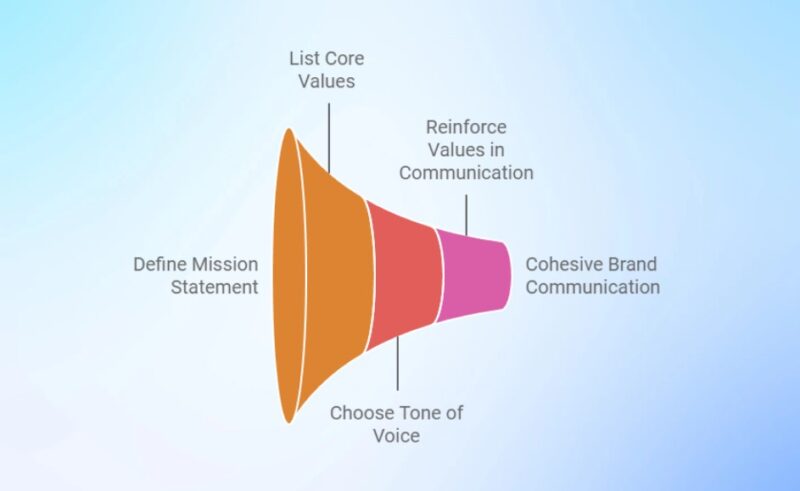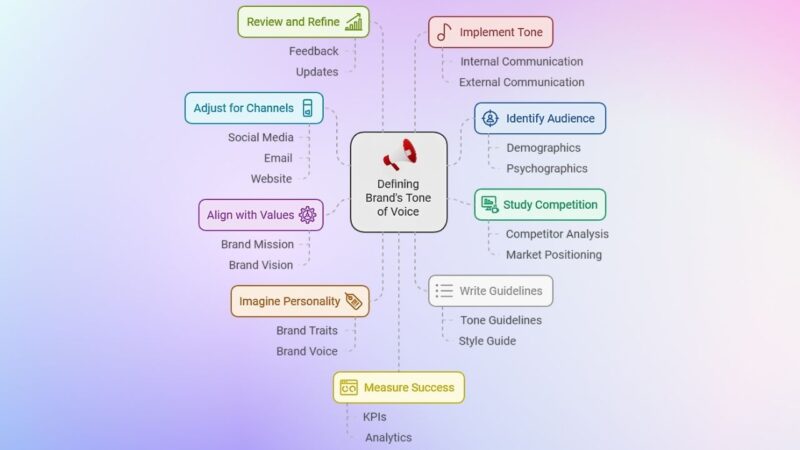When you think about your brand’s tone of voice, you’re not just considering the words your company uses. It’s deeper than that—your tone shapes how your brand is perceived and connects with your audience.
It’s about creating a consistent and recognizable voice that builds trust over time. If you’re looking to develop a tone of voice that resonates, here’s how to approach it step by step.
Step 1: Identify Who You’re Speaking To

Before you start shaping your brand’s tone, you need a solid grasp of who you’re talking to. Who are your customers? What do they care about? What challenges are they facing that your product or service helps solve?
Building detailed audience personas is a helpful way to answer these questions. Think about age, interests, pain points, and even the kind of language your customers use daily. This ensures your tone aligns with how they communicate.
For instance, if you’re selling to a group of young millennials, your tone might be light, playful, and casual. But if your audience is professionals in a specific industry, you’ll want to maintain an authoritative tone, reflecting expertise and professionalism.
Example Scenario
Imagine you’re a tech startup offering AI software to enterprise businesses. The tone you’ll want to strike is cutting-edge, innovative, and professional. This audience values efficiency and results, so your language should reflect that while staying clear and approachable.
Step 2: Study the Competition

It’s important to take a good look at how others in your industry communicate. This doesn’t mean copying them, but studying their tone of voice helps you pinpoint opportunities to stand out. Go through their websites, social media posts, email newsletters, and marketing campaigns.
What are they doing well? Where do they miss the mark? By understanding how they communicate, you can craft a tone that’s distinct yet authentic to your brand’s personality.
How to Differentiate Yourself
Let’s say you find most competitors in your field are stiff and formal in their communication. A way to set your brand apart could be adopting a more relaxed, conversational tone. Think of it like finding your brand’s unique voice within an already crowded space.
Step 3: Align with Your Brand’s Values and Vision

The tone of voice you choose should be a reflection of your brand’s core values and mission. If you haven’t defined those yet, now’s the time. A clear mission and values serve as a north star for all your communication.
How to Get Started
- Write out your brand’s mission statement.
- Make a list of the values that guide your business (e.g., innovation, transparency, customer-first mindset).
- Ensure that your tone of voice naturally reinforces those values.
For example, a company that prides itself on being innovative will likely use language that emphasizes fresh ideas, progress, and forward-thinking concepts. The tone will feel energized and forward-looking, consistently pushing boundaries.
Step 4: Imagine Your Brand’s Personality
If your brand were a person, what would they be like? This is a fun exercise that helps shape your brand’s voice. Think about personality traits, how your brand would sound in a conversation, and how it would react in different situations.
Choose three to five adjectives that sum up your brand’s personality. These traits will guide how your tone manifests in everything you do.
Example Adjectives
- Authoritative, friendly, and passionate.
- Quirky, witty, and energetic.
Once you have your brand’s personality traits pinned down, think about how they translate across various platforms. Would your brand crack jokes on social media, or stick to a serious, informative tone?
Step 5: Adjust for Different Communication Channels

While your core tone stays consistent, the way you express it might change slightly based on the channel you’re using. You wouldn’t use the exact same tone in a formal email as you would in an Instagram caption, for instance.
- Social Media: Your tone can be casual, engaging, and conversational here. The goal is to create a sense of connection and build a community.
- Website Copy: You’ll want to be more polished and informative, positioning your brand as a trusted authority.
- Emails: This depends on the context. A promotional email can be light and catchy, while a customer service email should be empathetic and solution-oriented.
Documenting these variations ensures that your tone stays consistent but adapts to the needs of different platforms.
Step 6: Write Your Brand Voice Guidelines

Having clear brand voice guidelines is essential for consistency, especially if multiple people create content for your company. Without these, it’s easy for the tone to shift, causing confusion for your audience.
What to Include
- A description of your brand’s tone: Write a few sentences that summarize the essence of your tone and how it ties to your brand’s personality.
- Dos and Don’ts: List out specific guidelines on what to do and avoid. For example:
- Do: Use approachable, clear language.
- Don’t: Be too formal or overly technical unless the situation demands it.
- Examples: Provide sample sentences for different types of content (e.g., a social media post vs. a formal business email).
Having clear guidelines will make it easier for your team to create content that consistently reflects your brand’s voice.
Step 7: Regularly Review and Refine
Your brand’s tone of voice isn’t a “set it and forget it” deal. As your business evolves, your audience may shift, or new communication platforms may emerge. Regular reviews of your tone are crucial to keep it relevant.
Make it a habit to review your tone of voice guidelines every year. Keep track of new trends or platforms and adjust as needed. Don’t hesitate to gather feedback from your team and audience to make sure your voice still resonates.
Step 8: Implement Your Tone Everywhere
Once you’ve defined your brand’s tone of voice, consistency is the name of the game. Apply your tone across all the different areas where your brand communicates.
Key Areas to Focus On
- Website copy
- Blog posts
- Social media content
- Marketing campaigns
- Email communications
It’s also important to train your team. Anyone involved in content creation—whether they’re writing social media posts or crafting email campaigns—needs to understand and be aligned with your brand’s voice. A training session or workshop can help ensure everyone is on the same page.
Step 9: Measure Success
Defining your tone of voice is just the first step. How do you know if it’s working? Measure how well your tone resonates with your audience by tracking key engagement metrics.
Key Metrics to Watch
- Social media engagement rates (likes, comments, shares)
- Website conversion rates
- Email open and click-through rates
You can also gather direct feedback through surveys. Ask customers if they feel connected to your brand and if the voice feels approachable and trustworthy. This kind of feedback is invaluable as you continue to refine your tone and it can also affect consumer’s decisions in the future.
Final Thoughts
Defining your brand’s tone of voice is one of the most strategic things you can do to build a recognizable and trustworthy brand. Start by knowing who you’re speaking to, aligning your tone with your core values, and creating clear guidelines.
Then, make sure to implement your tone consistently across all platforms, and review it regularly to stay fresh and aligned with your audience’s needs.
The key takeaway? Your brand’s tone is a living, breathing part of your company’s identity. Keep it flexible, review it often, and always make sure it reflects who you are and what your audience wants to hear.

